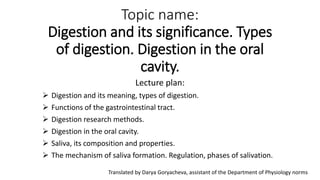
Digestion Breakdown: Saliva's Role
- 1. Topic name: Digestion and its significance. Types of digestion. Digestion in the oral cavity. Lecture plan: Digestion and its meaning, types of digestion. Functions of the gastrointestinal tract. Digestion research methods. Digestion in the oral cavity. Saliva, its composition and properties. The mechanism of saliva formation. Regulation, phases of salivation. Translated by Darya Goryacheva, assistant of the Department of Physiology norms
- 2. Digestion and its significance • Energy and plastic materials enter the body with food. Nutrients, other than mineral salts and water, are mechanically and chemically processed in the gastrointestinal tract. • In the process of digestion, large- molecular organic substances are converted into simple substances, monomers, which are absorbed into the blood and lymph and absorbed by the body. crushing liquefaction, dissolution denaturation depolymerization to oligomers depolymerization to monomers suction 6-10 liters Food 800-1000 g Water 1.2-1.5 l Saliva – 0.5-2 l Gastric juice – 2-2.5 l Bile – 0.5-1 l Pancreatic juice – 1.5-2 l Small intestine juice 1.5-2 l Colon juice - 0.05-0.06 l Feces: 0.15-, 025 l of water, 50-100 g - food debris, bacteria, epithelium
- 3. Main types of digestion 1. Autolytic: enzymes can be absorbed through food (breast milk). 2. Symbiotic: enzymes are produced by bacteria - hydrolysis by enzymes of microorganisms (in the large intestine). 3. Own type of digestion a) cavity (distant) digestion - the hydrolytic action of enzymes is realized in the cavities of the digestive tract. b) parietal (contact, membrane) digestion - an increase in hydrolytic processes takes place in the mucous layer and in the area of the brush border of enterocytes. c) intracellular (phagocytosis, pinocytosis).
- 4. Functions of the gastrointestinal tract 1. Digestive. The secretory function is the secretion of digestive juices. • There are 3 groups of enzymes: 1) proteases that break down proteins; 2) lipases that digest fats to glycerides and fatty acids; 3) carbohydrases, which digest carbohydrates to polysaccharides, di- and monosaccharides. Motor function. Suction function. Excretory function. 2. Endocrine function. • In the cells of the mucous membrane of the stomach, intestines, pancreas, active substances (gastrointestinal hormones) are synthesized, which exert their effect by entering the blood. • Hormones of the enteric system provide: 1) enhance or inhibit the secretion of digestive juices. 2) act on metabolism - assimilation, on the growth and development of a growing organism. 3) have a trophic effect, improve the blood supply to organs, and increase the permeability of biological membranes.
- 5. Digestion research methods To study the digestive function in humans, clinical methods are used: introduction of a probe, radiography, electrogastrography, radiotelemetric technique, endoscopy, the method of introducing radioactive isotopes, ultrasound, etc. І. Experimental vivisection isolated organs chronic experiences I. Pavlov and his co-workers developed operations to obtain all digestive juices in conditions of chronic experience - fistula operations. II. Clinical and physiological
- 6. Digestion in the oral cavity. • The digestion process begins in the mouth. Food in the oral cavity is 15-30 seconds. During this time, food is subjected to mechanical, physical, and chemical processing. Functions of the oral mucosa 1. Secretory. 2. Protective. 3. Regenerative. 4. Suction. 5. Reflexogenic zone
- 7. Saliva, its composition and meaning • Saliva is a mixed secret secreted by 3 pairs of salivary glands (parotid, submandibular, sublingual and many small glands). • A person produces 600-1500 ml of saliva per day, an average of 1.0- 1.2 liters. Oral cavity Trachea Resting state Epiglottis Tongue Esophagus The act of swallowing
- 8. Saliva composition 1. Enzymes: • Salivary amylase (-amylase) - initial hydrolysis of polysaccharides - to dextrans - disaccharides • Maltase released during prolonged chewing - disaccharides - disaccharides to monosaccharides. 2. Mucin 3. Lysozyme Traces: • Proteins, globulins, amino acids. • Uric acid, urea, creatinine • Enzymes: proteases, peptides, lipase, nuclease, alkaline and acid phosphatases, etc. 1. Ions of potassium, sodium, calcium, magnesium. 2. Phosphates, chlorides, sulfates, bicarbonates. 3. Rhodonous compounds. 4. Iodide, bromide, fluorine, trace elements: iron, nickel, lithium Saliva is a digestive juice, slightly colorless, viscous, opalescent liquid. The specific gravity is 1.001-1.002. pH = 5.8-7.4. Water - 99.4-99.5%. Dry residue - 0.5-0.6% Organic substances Inorganic substances
- 9. Dry food (crackers, meat powder) produces more saliva than milk. A lot of liquid saliva is released on the rejected substances (sand, acid).
- 10. Salivation mechanism • Afferent impulses from the receptors in the oral cavity go to the center of salivation in the medulla oblongata along the afferent fibers of the trigeminal, facial, glossopharyngeal and vagus nerves. From there along the efferent fibers to the salivary glands along the sympathetic and parasympathetic nerves.
- 11. When sympathetic nerves are irritated, sympathetic saliva is thick, rich in organic compounds, not abundant. With irritation of the parasympathetic nerves - chordal - liquid, abundant, rich in minerals.
- 12. Reflex mechanism of saliva secretion • 2 phases of salivation: 1. Conditioned reflex phase. The separation of saliva occurs before food enters the oral cavity at the sight of food, smelling, memories of food, etc. It is carried out with the help of the cortex and the center of salivation. 2. Unconditioned reflex phase. The separation of saliva occurs when food enters the oral cavity, the receptors of the oral cavity are irritated. Along the afferent nerves, impulses reach the center of salivation and from there along the secretory nerves to the salivary glands.
- 13. THANK YOU FOR YOUR ATTENTION!